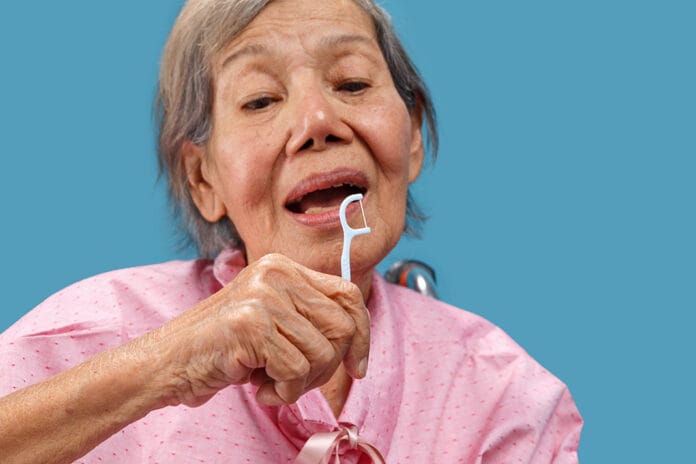Dental hygienists are trained to help people with limited dexterity or the inability to use their hands normally, and they find efficient ways to care for those dental patients’ teeth. We work hard to stay up to date on the latest gadgets to aid with daily home care and interdental cleaning.
The market is full of solutions that we can explore with these patients. However, we tend to have our go-to recommendations and might not stop to think about how the recommendation will play out in the patient’s daily routine.
I was recently forced to think about this when I had surgery on my right index finger. It surely was a nightmare situation for a dental hygienist, but that is another story. Besides the fear for my career, I was suddenly thrust into the position of a dental patient with no use of my right hand. I had a full cast on my hand and up my arm for several weeks and then a more streamlined splint for two more months. I had exposed pins sticking out of my finger, so I was to avoid getting it wet to avoid infection.
I tend to have, of course, very low tolerance for my teeth being dirty. However, with everything going on and my extreme frustration at not being able to accomplish formerly basic tasks, my home care motivation quickly waned.
When the Dominant Hand is Disabled
Then I got to thinking about all my patients who have had strokes, are missing fingers or hands, or suffer from debilitating arthritis. Formerly, I would give them a bunch of stuff like floss picks, interdental brushes, or whatever I thought would work for their teeth. The problem, though, was exactly that. I was too focused on their teeth. In my new, left-hand-only world, I could see why many of these patients return with no improvement in their hygiene.
In the beginning, I was so right-hand dominant that I could hardly get a spoon in my mouth without making a mess. I was thankful that I already owned an electric toothbrush. With its larger handle and automatic agitation, I was able to slowly move it around my mouth and do a fairly decent job brushing. I’m sure I would not have been able to manipulate a manual toothbrush enough to achieve the same effect.
Then came flossing. With one hand, my impeccable flossing skills went out the window. Traditional string floss was out of the question. My first thought was a floss holder, where I could wind the floss around some plastic fingers and then be able to floss one-handed. This proved impossible, as I was not able to anchor the floss holder enough to load the floss onto it properly. Interdental brushes and picks also were not an option because of how my teeth are positioned.
So, I moved on to some little floss picks. The floss on them was very thick and waxy, which made them difficult to fit between my teeth. I was cutting my gingiva all over the place as it slammed into my papilla and gingiva after squeezing through my tight contacts. A hygienist with bleeding gingiva is not a happy hygienist!
Next up was an oral irrigator that I regularly recommend to patients with dexterity issues and also to patients with appliances such as bridges or orthodontics. In hindsight, my first attempt was nothing short of comedic. Water flew everywhere ‒ onto the mirror, the counter, down my shirt, and all over my face. I could not believe how bad I was at this. I wondered about my patients whom I had encouraged to make an investment in this device. Would they give up after struggling like this? If I didn’t care about my teeth as much as I do, I would have given up at this point.
Can a Patient Adapt to the Device?
I was unexpectedly filled with empathy for all the people I had supposedly given solutions for their home hygiene needs. Yes, there are good devices out there. But can the patient really use them? What is their situation really like at home? What is their motivation level? Is their disability a new situation, or are they well-accustomed to adapting their habits? Most of all, are they physically able to do the things we are recommending? I was not.
I stubbornly continued using my oral irrigator daily until I felt much more comfortable and did not have to wipe down the bathroom with a towel when I was done. However, within a time span of three months, I was mortified to look in the mirror and see coffee stains and moderate calculus between my teeth. Luckily, my hygienist loves me and quickly found a spot for me in her schedule to get fixed up.
Now I am back to work, and my finger is better than ever. With my newfound understanding of disabilities and dental hygiene, I have changed my approach to home care instructions. It is not about gadgets and encouragement. It is about the patient.
Now, before recommending a device, I ask myself if the patient can really use it at home. This might involve sitting up the patient, holding a mirror for them, and having them give it a try. I guide them as they go and have them try different areas of the mouth. It is important to ask them how they feel about it because they will not use it at home if they think it is too hard. Finally, my internal grumbling at patients returning once again with a mouth full of stains and calculus has been silenced. It is hard for patients with manual disabilities and dexterity issues, not just with flossing but perhaps in life in general. Only through understanding and patient, detailed coaching can we see results.
Before you leave, check out the Today’s RDH self-study CE courses. All courses are peer-reviewed and non-sponsored to focus solely on high-quality education. Click here now.















